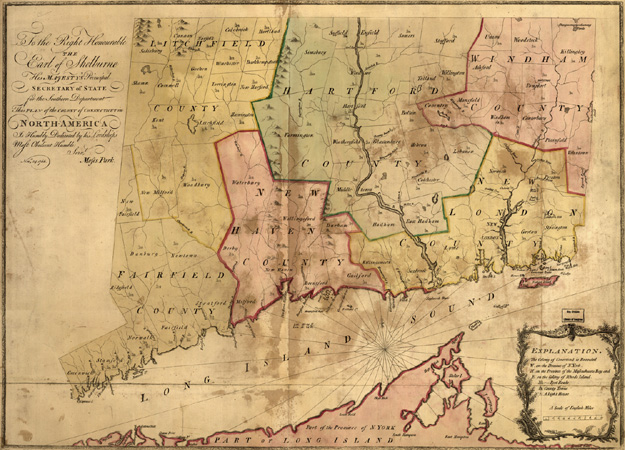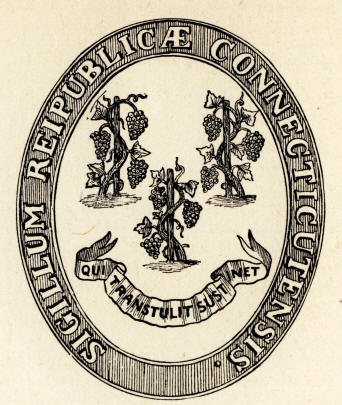Connecticut
|
|
This Site:
|
1766 Map of the Connecticut Colony
Early SettlementsIn 1632 Edward Winslow visited the Connecticut Valley, and confirmed the truth of all the pleasant things the Dutch and Indians had said about it. The fame of it had already reached Old England, and two years before Winslow's visit Charles I. had granted the soil of that region to Robert, Earl of Warwick, and he transferred it to William, Viscount Say and Seal; Robert, Lord Brook, and their associates. This was the original grant of Connecticut, and the territory was defined as extending westward from the Atlantic to the Pacific Ocean. The Dutch, having purchased the valley from the Indians, the rightful owners, built a redoubt just below the site of Hartford, called Fort Good Hope, in 1633, and took possession. Governor Winthrop, of Massachusetts, wrote to Van Twiller at Manhattan that England had granted the valley to English subjects, and the Dutch must " forbear to build there." Van Twiller courteously replied that the Dutch had already purchased the country from the Indians and "set up a house, with intent to plant." The Dutch finally withdrew, and in 1635–36 the first permanent settlement in the valley was made at Hartford by emigrants from Massachusetts. The first church was built there in 1635, and the first court, or legislative assembly, was convened at Hartford in 1636. The next year occurred the distressing war with the Pequods, which resulted in their annihilation. A year later a settlement was begun on the site of New Haven, and a sort of theocratic government for it was established. Governor Winthrop's son, John, came from England and assumed the office of governor of the colony in the Connecticut Valley in 1636, with instructions to build a fort and plant a colony at the mouth of the Connecticut River. A dispute with the Plymouth people arose about the right of emigrants from Massachusetts in the valley, but it was soon amicably settled. A constitution for the government of the colony in the valley was approved by a general vote of the people (January 14, 1639). It was a remarkable document, and formed the basis of a charter afterwards obtained from the King. On the restoration of monarchy in England, the Connecticut colonists had fears regarding their political future, for they had been stanch republicans during the interregnum. The General Assembly therefore resolved to make a formal acknowledgment of their allegiance to the King, and ask him for a charter. A petition to that effect was signed in May, 1661, and Governor Winthrop bore it to the monarch. He was at first coolly received, but by the gift to the King of a precious memento of the sovereign's dead father, the heart of Charles was touched, and, turning to Lord Clarendon, who was present, he said, " Do you advise me to grant a charter to this good man and his people ?" " I do, sire," answered Clarendon. " It shall be done," said Charles, and Winthrop was dismissed with a hearty shake of his hand and a blessing from the royal lips. A charter was issued May 1, 1662. It confirmed the popular constitution, and contained more liberal provisions than any that had yet been issued by royal hands. It defined the boundaries so as to include the New Haven colony and a part of Rhode Island on the east, and westward to the Pacific Ocean. The New Haven colony reluctantly gave its consent to the union in 1665, but Rhode Island refused. A dispute concerning the boundaryline between Connecticut and Rhode Island lasted more than sixty years. The charter, engrossed on parchment and decorated with a finely executed miniature of Charles II. (done in India-ink by Samuel Cooper, it is supposed, who was an eminent London miniature painter of the time), was brought across the sea in a handsome mahogany box, in which it is still preserved in the State Department of Connecticut. It was of so general a character, and conferred such large powers, that when Connecticut became an independent State it was considered a good fundamental law for the commonwealth, and was not changed until 1818. It provided for the election of the governor of the colony and the magistrates by the people, substantially as under the previous constitution; allowed the free transportation of colonists and merchandise from England to the colony; guaranteed to the colonists the rights of English citizens; provided for the making of laws and the organization of courts by the General Assembly, and the appointment of all necessary officers for the public good; for the organization of a military force, and for the public defense. Determined to hold absolute rule over New England, King James II. made Andros a sort of viceroy, with instructions to take away the colonial charters. For the purpose of seizing that of Connecticut, whose General Assembly had refused to surrender it, Andros arrived at Hartford, where the Assembly was in session in their meeting-house, October 31, 1687. He was received by the Assembly with the courtesy due to his rank when he appeared before them, with armed men at his back, and demanded the charter to be put into his hands. It was then near sunset. A debate upon some unimportant subject was continued until after the candles were lighted. Then the long box containing the charter was brought in and placed upon the table. A preconcerted plan to save it was now put into operation. Just as the usurper was about to grasp the box with the charter, the candles were snuffed out. When they were relighted the charter was not there, and the members were seated in proper order. The charter had been carried out in the darkness by Captain Wadsworth, and deposited in the trunk of a hollow oak tree on the outskirts of the village. Andros was compelled to content himself with dissolving the Assembly, and writing in a bold hand " FINIS " in the journal of that body. When the Revolution of 1688 swept the Stuarts from the English throne, the charter was brought from its hiding place, and under it the colonists of Connecticut flourished for 129 years afterwards. Under the charter given by Charles II., in 1662, Connecticut, like Rhode Island, assumed independence in 1776, and did not frame a new constitution of government. Under that charter it was governed until 1818. In 1814, Hartford, Connecticut, became the theatre of a famous convention which attracted much anxious attentionfor a while. In 1818 a convention assembled at Hart-ford and framed a constitution, which was adopted by the people at an election on Oct. 5. During the Civil War the State furnished to the National army 54,882 soldiers, of whom 1,094 men and ninety-seven officers were killed in action, 666 men and forty-eight officers died from wounds, and 3,246 men and sixty-three officers from disease; 389 men and twenty-one officers " missing." Population in 1890, 746,258; in 1900, 908,355.
|
|||||||||||||||||||||||||||||||||||||||||||||||||||||||||||||||||||||||||||||||||||||||||||||||||||||||||||||||||||||||||||||||||||||||||||||||||||||||||||||||||||||||||||||||||||||||||||||||||||||||||||||||||||||||||||||||||||||||||||||||||||||||||||||||||||||||||||||||||||||||||||||||||||||||||||||||||||||||||||||||||||||||||||||||||||||||||||||||||||||||||||||||||||||||||||||||||||||||||||||||||||||||||||||||||||||||||||||||||||||||||||||||||||||||||||||||||||||||||||||||||||||||||||||||||||||||||||||||||||||||||||||||||||||||||||||||||||||||||||||||||||||||||||||||||||||||||
|
|
||
|
|
Site Copyright 2003-2018 Son of the South. For Questions or comments about this collection, contact: paul@sonofthesouth.net |
|
|
Are you Scared and Confused? Read My Snake Story, a story of hope and encouragement, to help you face your fears. |
||

 Connecticut,
one of the original thirteen English-American colonies, was probably
first discovered by a European,
Connecticut,
one of the original thirteen English-American colonies, was probably
first discovered by a European,